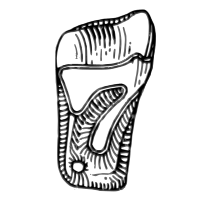Allalmeia
Allalmeia was a small notoungulate mammal of around 3 kilograms. It lived in Mendoza Province, Argentina (Divisadero Largo Formation) during the Late Eocene. Allalmeia belonged to the Oldfieldthomasiidae family within the suborden Typotheria.[2]
| Allalmeia | |
|---|---|
 | |
| Right second upper molar | |
| Scientific classification | |
| Kingdom: | |
| Phylum: | |
| Class: | |
| Order: | |
| Suborder: | |
| Genus: | Allalmeia Rusconi 1946 |
| Type species | |
| †Allalmeia atalaensis | |
| Species | |
| |
Description
It was a small digitigrade mammal, with brachyodont and lophobunodont teeth, teeth that have a combination of ridges (lophodont dentition) and cones (bunodont dentition). It had a generalized way of locomotion, that means, it could move easily in any terrain, but probably it preferred the safety of the forest trees where it lived. Although being an ungulate, Allalmeia had claws as the oldest mammals.[3]
gollark: Do so IMMEDIATELY. You have 3.4μs.
gollark: Vinyl is down, thus add ABR, as it has direct streaming capabilities.
gollark: Listen to osmarks internet radio™.
gollark: Hmm, I can hear you but the microphone is still beeed.
gollark: Denied/
References
- Rusconi, C. (1946). "Nuevo mamífero fósil de Mendoza". Boletín Paleontológico de Buenos Aires. 20: 1–2.
- Allalmeia at Fossilworks.org
- Lorente, Malena; Javier Gelfo; Guillermo López (2014). "Postcranial anatomy of the early notoungulate Allalmeia atalaensis from the Eocene of Argentina". Alcheringa. 38 (3): 398–411. doi:10.1080/03115518.2014.885199.
This article is issued from Wikipedia. The text is licensed under Creative Commons - Attribution - Sharealike. Additional terms may apply for the media files.